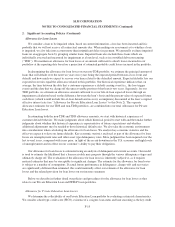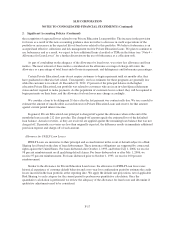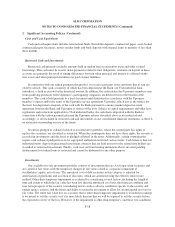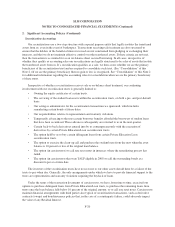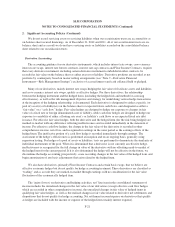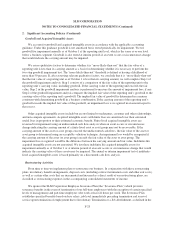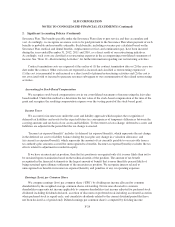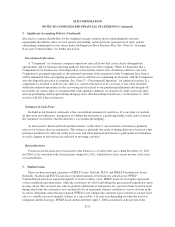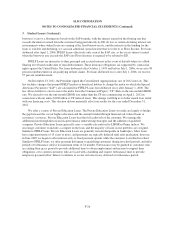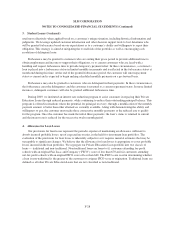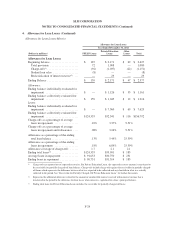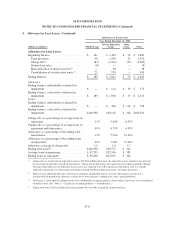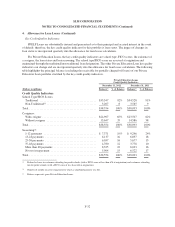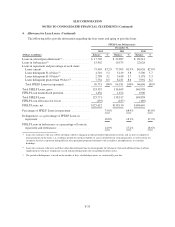Sallie Mae 2012 Annual Report Download - page 133
Download and view the complete annual report
Please find page 133 of the 2012 Sallie Mae annual report below. You can navigate through the pages in the report by either clicking on the pages listed below, or by using the keyword search tool below to find specific information within the annual report.SLM CORPORATION
NOTES TO CONSOLIDATED FINANCIAL STATEMENTS (Continued)
2. Significant Accounting Policies (Continued)
Goodwill and Acquired Intangible Assets
We account for goodwill and acquired intangible assets in accordance with the applicable accounting
guidance. Under this guidance goodwill is not amortized but is tested periodically for impairment. We test
goodwill for impairment annually as of October 1 at the reporting unit level, which is the same as or one level
below a business segment. Goodwill is also tested at interim periods if an event occurs or circumstances change
that would indicate the carrying amount may be impaired.
We assess qualitative factors to determine whether it is “more-likely-than-not” that the fair value of a
reporting unit is less than its carrying amount as a basis for determining whether it is necessary to perform the
two-step goodwill impairment test. The “more-likely-than-not” threshold is defined as having a likelihood of
more than 50 percent. If, after assessing relevant qualitative factors, we conclude that it is “more-likely-than-not”
that the fair value of a reporting unit as of October 1 is less than its carrying amount, we will complete Step 1 of
the goodwill impairment analysis. Step 1 consists of a comparison of the fair value of the reporting unit to the
reporting unit’s carrying value, including goodwill. If the carrying value of the reporting unit exceeds the fair
value, Step 2 in the goodwill impairment analysis is performed to measure the amount of impairment loss, if any.
Step 2 of the goodwill impairment analysis compares the implied fair value of the reporting unit’s goodwill to the
carrying value of the reporting unit’s goodwill. The implied fair value of goodwill is determined in a manner
consistent with determining goodwill in a business combination. If the carrying amount of the reporting unit’s
goodwill exceeds the implied fair value of the goodwill, an impairment loss is recognized in an amount equal to
that excess.
Other acquired intangible assets include but are not limited to tradenames, customer and other relationships,
and non-compete agreements. Acquired intangible assets with finite lives are amortized over their estimated
useful lives in proportion to their estimated economic benefit. Finite-lived acquired intangible assets are
reviewed for impairment using an undiscounted cash flow analysis when an event occurs or circumstances
change indicating the carrying amount of a finite-lived asset or asset group may not be recoverable. If the
carrying amount of the asset or asset groups exceeds the undiscounted cash flows, the fair value of the asset or
asset group is determined using an acceptable valuation technique. An impairment loss would be recognized if
the carrying amount of the asset (or asset group) exceeds the fair value of the asset or asset group. The
impairment loss recognized would be the difference between the carrying amount and fair value. Indefinite-life
acquired intangible assets are not amortized. We test these indefinite life acquired intangible assets for
impairment annually as of October 1 or at interim periods if an event occurs or circumstances change that would
indicate the carrying value of these assets may be impaired. The annual or interim impairment test of indefinite-
lived acquired intangible assets is based primarily on a discounted cash flow analysis.
Restructuring Activities
From time to time we implement plans to restructure our business. In conjunction with these restructuring
plans, involuntary benefit arrangements, disposal costs (including contract termination costs and other exit costs),
as well as certain other costs that are incremental and incurred as a direct result of our restructuring plans, are
classified as restructuring expenses in the accompanying consolidated statements of income.
We sponsor the SLM Corporation Employee Severance Plan (the “Severance Plan”) which provides
severance benefits in the event of termination of our full-time employees (with the exception of certain specified
levels of management) and part-time employees who work at least 24 hours per week. The Severance Plan
establishes specified benefits based on base salary, job level immediately preceding termination and years of
service upon termination of employment due to Involuntary Termination or a Job Abolishment, as defined in the
F-23




